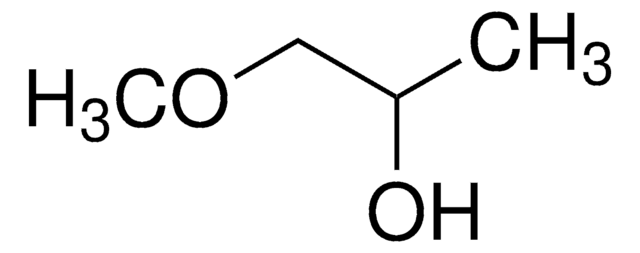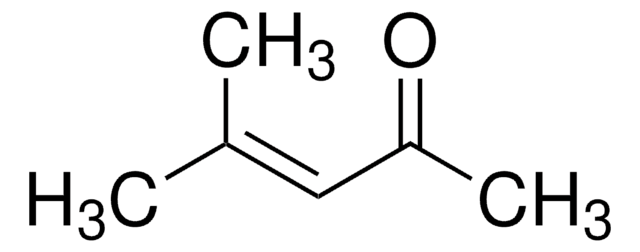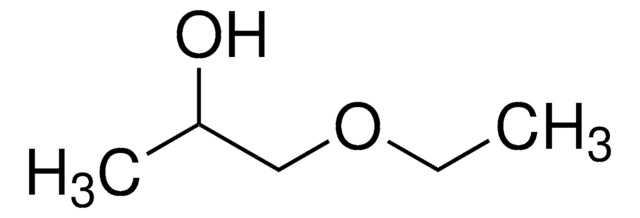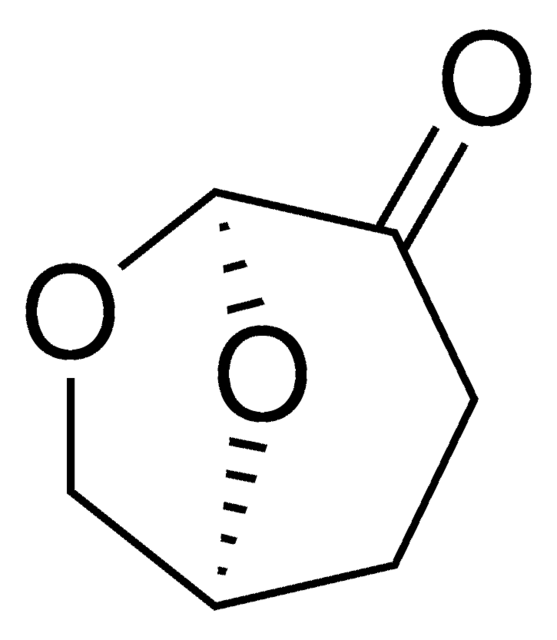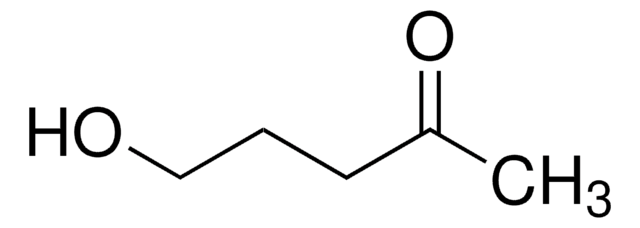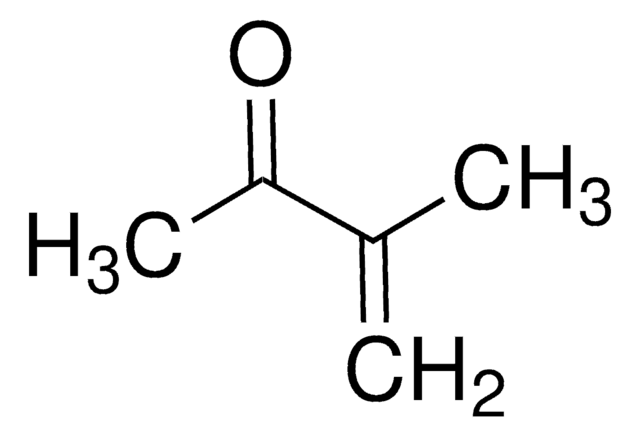H41544
4-Hydroxy-4-methyl-2-pentanone
99%
Synonym(s):
Diacetone alcohol
Sign Into View Organizational & Contract Pricing
All Photos(1)
About This Item
Linear Formula:
(CH3)2C(OH)CH2COCH3
CAS Number:
Molecular Weight:
116.16
Beilstein:
1740440
EC Number:
MDL number:
UNSPSC Code:
12352100
PubChem Substance ID:
NACRES:
NA.22
Recommended Products
vapor density
4 (vs air)
Quality Level
vapor pressure
<1 mmHg ( 20 °C)
Assay
99%
form
liquid
expl. lim.
6.9 %
refractive index
n20/D 1.423 (lit.)
bp
166 °C (lit.)
density
0.931 g/mL at 25 °C (lit.)
SMILES string
CC(=O)CC(C)(C)O
InChI
1S/C6H12O2/c1-5(7)4-6(2,3)8/h8H,4H2,1-3H3
InChI key
SWXVUIWOUIDPGS-UHFFFAOYSA-N
Looking for similar products? Visit Product Comparison Guide
General description
4-Hydroxy-4-methyl-2-pentanone is commonly used as a solvent in various industries, including paints, coatings, adhesives, and printing inks.
Application
4-Hydroxy-4-methyl-2-pentanone can be used to synthesize:
It can also be used as a complexing agent to synthesize double-metal cyanide (DMC) catalysts by reacting with metal salt (MX) and cyanometalate compounds.
- Diolmonoesters by reacting with aldehydes via tandem aldol-transfer–Tischtschenko reaction catalyzed by trimethylaluminum.
- Aldol-transfer products such as β-hydroxy ketones by reacting with various aldehydes in the presence of L-proline as a catalyst.
- Mono-α-arylated ketones and esters via Pd catalyzed reaction with aryl halides and aryl triflates, respectively.
It can also be used as a complexing agent to synthesize double-metal cyanide (DMC) catalysts by reacting with metal salt (MX) and cyanometalate compounds.
Signal Word
Warning
Hazard Statements
Precautionary Statements
Hazard Classifications
Eye Irrit. 2 - Flam. Liq. 3 - Repr. 2 - STOT SE 3
Target Organs
Respiratory system
Storage Class Code
3 - Flammable liquids
WGK
WGK 1
Flash Point(F)
136.4 °F - closed cup
Flash Point(C)
58 °C - closed cup
Personal Protective Equipment
dust mask type N95 (US), Eyeshields, Gloves
Choose from one of the most recent versions:
Already Own This Product?
Find documentation for the products that you have recently purchased in the Document Library.
Customers Also Viewed
I Magneron et al.
Environmental science & technology, 37(18), 4170-4181 (2003-10-04)
The OH-initiated oxidation of two VOCs directly emitted to the atmosphere through their use as industrial solvents, hexylene glycol (HG, (CH3)2C(OH)CH2CH(OH)CH3) and diacetone alcohol (DA, (CH3)2C(OH)CH2C(O)CH3), has been studied in two photoreactors: a 140 L Teflon bag irradiated by lamps
Molecular probes of the mechanism of cytochrome P450. Oxygen traps a substrate radical intermediate.
Harriet L R Cooper et al.
Archives of biochemistry and biophysics, 507(1), 111-118 (2010-11-16)
The diagnostic substrate tetramethylcyclopropane (TMCP) has been reexamined as a substrate with three drug- and xenobiotic-metabolizing cytochrome P450 enzymes, human CYP2E1, CYP3A4 and rat CYP2B1. The major hydroxylation product in all cases was the unrearranged primary alcohol along with smaller
Tandem aldol-transfer-Tischtschenko reaction of aldehydes and ?-hydroxyketones catalyzed by trimethylaluminum
Simpura I and Nevalainen V
Tetrahedron Letters, 42(23), 3905-3907 (2001)
Synthesis of Polycarbonate Polyols by Double-Metal Cyanide Catalyzed Copolymerization of Epoxide with Carbon Dioxide
Lim J, et al.
Journal of Nanoscience and Nanotechnology, 17(10), 7507-7514 (2017)
S Chandrasekhar et al.
Chemical communications (Cambridge, England), (21)(21), 2450-2451 (2004-10-30)
We demonstrate for the first time, L-proline as a chiral catalyst for transfer aldol reaction between aldehydes and diacetone alcohol.
Our team of scientists has experience in all areas of research including Life Science, Material Science, Chemical Synthesis, Chromatography, Analytical and many others.
Contact Technical Service
